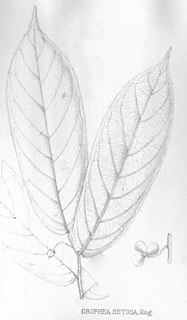Pseuduvaria taipingensis is a species of plant in the family Annonaceae. It is a tree endemic to Peninsular Malaysia. James Sinclair, the Scottish botanist who first formally described the species, named it after Taiping a city in Perak, Malaysia where the specimen he examined was collected.
Pseuduvaria costata is a species of plant in the family Annonaceae. It is native to New Guinea. Rudolph Scheffer, the Dutch botanist who first formally described the species using the basionym Orophea costata, named it after its prominently ribbed fruit.
Pseuduvaria cymosa is a species of plant in the family Annonaceae. It is native to Peninsular Malaysia. James Sinclair, the Scottish botanist who first formally described the species using the synonym Pseuduvaria macrophylla var. cymosa, named it after its branched inflorescences which are called cymes.
Pseuduvaria dielsiana is a species of plant in the family Annonaceae. It is native to New Guinea. Carl Lauterbach, the German botanist who first formally described the species using the synonym Goniothalamus dielsianus, named it in honor of Ludwig Diels, another German botanist who also worked on taxa from New Guinea.
Pseuduvaria glabrescens is a species of plant in the family Annonaceae. It is native to Australia. L.W. Jessup, the botanist who first formally described the species using the synonym Pseuduvaria mulgraveana var. glabrescens, named it after the underside of its leaves which have the quality of becoming hairless as they mature.
Pseuduvaria grandifolia is a species of plant in the family Annonaceae. It is native to New Guinea. Otto Warburg, the German-Jewish botanists who first formally described the species using the basionym Stelechocarpus grandifolius, named it after its large leaves.
Pseuduvaria hylandii is a species of plant in the family Annonaceae. It is native to Australia. L.W. Jessup, the botanists who first formally described the species, named it after Bernard Hyland an Australian botanist who collected the specimen he examined.
Pseuduvaria kingiana is a species of plant in the family Annonaceae. It is native to the Malay Peninsula. Yvonne Chuan Fang Su and Richard Saunders, the botanists who first formally described the species, named it after Sir George King, the British botanist who first collected the species.
Pseuduvaria lignocarpa is a species of plant in the family Annonaceae. It is native to New Guinea. James Sinclair, the Scottish botanist who first formally described the species, named it after the woody wall of its fruit.
Pseuduvaria luzonensis is a species of plant in the family Annonaceae. It is native to The Philippines. Elmer Drew Merrill, the American botanist who first formally described the species using the synonym Orophea luzoniensis, named it after Luzon in the Province of Battan, Philippines where the specimen he examined was collected along the Lamao River.
Pseuduvaria macgregorii is a species of plant in the family Annonaceae. It is native to The Philippines. Elmer Drew Merrill, the American botanist who first formally described the species, named it after Richard MacGregor the Australian ornithologist and plant collector who collected the specimen Merrill examined.

Pseuduvaria macrocarpa is a species of plant in the family Annonaceae. It is native to The Maluku Islands and New Guinea. William Burck, the Dutch botanist who first formally described the species using the synonym Meiogyne macrocarpa, named it after its large fruit.
Pseuduvaria mindorensis is a species of plant in the family Annonaceae. It is native to the Philippines. Yvonne Su and Richard Saunders, the botanists who first formally described the species, named it after the island of Mindoro where the specimen they examined was collected in the municipality of Puerto Galera.
Pseuduvaria mollis is a species of plant in the family Annonaceae. It is native to New Guinea. Otto Warburg, the German-Jewish botanists who first formally described the species using the basionym Goniothalamus mollis, named it after the soft hairs on its leaves and petals.
Pseuduvaria mulgraveana is a species of plant in the family Annonaceae. It is native to Australia. L.W. Jessup, the botanist who first formally described the species, named it after the Mulgrave River in Goldsborough, Queensland where the specimen he examined was collected.
Pseuduvaria philippinensis is a species of plant in the family Annonaceae. It is native to the Philippines. Elmer Drew Merrill, the botanist who first formally described the species, named it after the Philippines where the specimen he examined was collected in the Province of Quezon.
Pseuduvaria sessilifolia is a species of plant in the family Annonaceae. It is native to New Guinea. James Sinclair, the botanist who first formally described the species, named it after its stalkless leaves which lack petioles.

Pseuduvaria setosa is a species of plant in the family Annonaceae. It is native to Peninsular Malaysia. George King, the botanist who first formally described the species under the basionym Orophea setosa, named it after the bristly hairs on its leaves and petioles.
Pseuduvaria silvestris is a species of plant in the family Annonaceae. It is native to New Guinea. Ludwig Diels, the botanist who first formally described the species under the basionym Orophea silvestris, named it after the forested habitat the specimens he examined were found growing in near the Waria River.
Pseuduvaria villosa is a species of plant in the family Annonaceae. It is endemic to Australia. L.W. Jessup, the botanist who first formally described the species, named it after its leaves and branchlets which are shaggy with long soft hairs.


